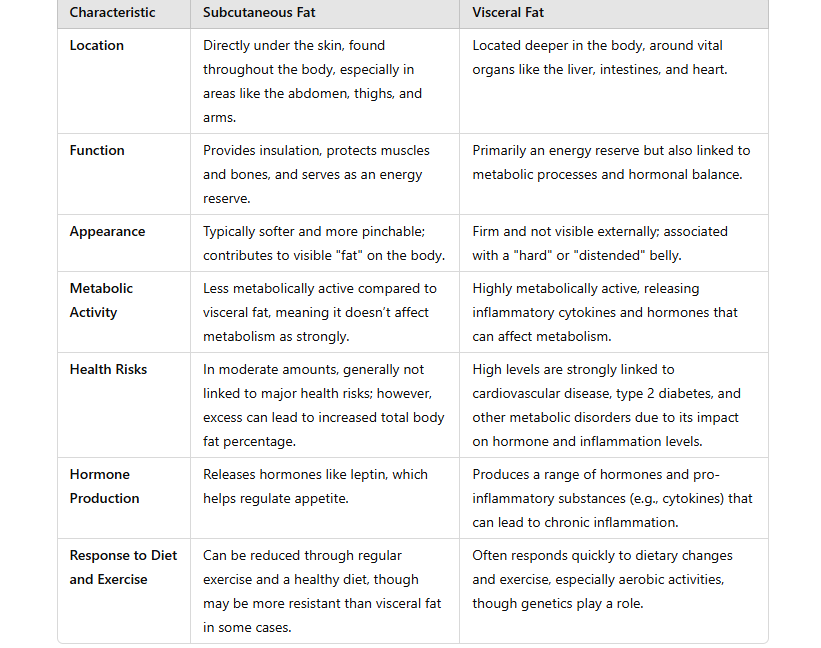Gaining Belly Fat & Feeling Hungry as Hell?
Welcome to Menopause symptoms #6 & #7!
Both these phenomenon are related to a loss of Estrogen (Estradiol) in your body.
What can you do about it?
Expect your body to change some.
Fight to maintain/build your capability to live the life you want, and stay fueled and NOT hangry in the meantime!
TOP Priorities
1. Lift Heavy 2-4x/week
2. EAT 6 cups/800 grams of fruits & veggies/day
3. .8-1 g protein per pound
Assuming...
Sleep/unfiltered light
Mitigate Stress
6-7k Steps
Even better:
HIIT
Limit alcohol
MHT
METHODS
1. Food: Magic 3
2. Get acquainted with the weight room:
- glossary
- step one dumbbell strength routine
- progressive overload (barbells)
Adapt visceral fat by:
While subcutaneous fat often decreases with a calorie deficit alone, visceral fat is more complex, responding not only to caloric restriction but also to lifestyle factors, especially exercise and stress management.
Here are the components
1. Exercise Type and Intensity
Low-to-Moderate intensity exercise. AKA, "take a walk." Possibly add a 10-15 pound weight vest to it. Aim for 150 minutes per week, minimum, or five 30-minute walks per week.
Strength & Hypertrophy Training: lift super-heavy for 6 or fewer reps + lift less heavy for 6-12 reps on at least two days per week, but three days is more effective.
High-Intensity Interval Training (HIIT): Short, intense bursts of activity followed by rest periods are especially effective for targeting visceral fat. HIIT workouts increase caloric expenditure and improve insulin sensitivity, which influences visceral fat levels.
Frequency recommendation is 1-2 times per week. Example HIIT Workout: five 25-second assault bike sprints, with 1-2 minutes rest in between each sprint.
2. Dietary Adjustments
Create a small calorie deficit, ~200 calories per day.
Fiber-Rich Foods: Increasing soluble fiber (found in foods like oats, fruits, and vegetables) can reduce visceral fat, as it helps regulate blood sugar and improve gut health, both of which are linked to visceral fat accumulation. Aim for 25-30 grams of fiber per day.
Prioritize Protein: Higher protein intake can aid in satiety and help prevent muscle loss while in a calorie deficit, which indirectly supports visceral fat reduction by promoting metabolic health. Aim for 0.8 - 1 gram of protein per pound of body weight.
3. Reduce Chronic Stress
Chronic stress increases cortisol, which is linked to visceral fat accumulation, particularly around the abdomen. Practicing stress-reducing techniques like mindfulness, deep breathing exercises, and regular physical activity can lower cortisol levels and assist in reducing visceral fat.
4. Sleep Quality and Duration
Poor sleep or less than 6–7 hours per night has been shown to increase visceral fat. Improving sleep hygiene and aiming for consistent, high-quality sleep can help with overall body composition and specifically target visceral fat.
5. Limit Alcohol Consumption
Alcohol, especially in excess, is linked to increased visceral fat. Moderation or abstaining can improve insulin sensitivity and help the body prioritize fat as an energy source. No amount is good for health; aim to drink progressively less, moving toward zero drinks most of the time.
Ready to Revolutionize your Life in Menopause with Anne?
***Click Here* to book a free chat with Anne to discuss 1:1 Coaching**
Or DM me “Menopause Body” on Instagram to start a chat
**Click Here to join the No Pause Club + Training Programming**

